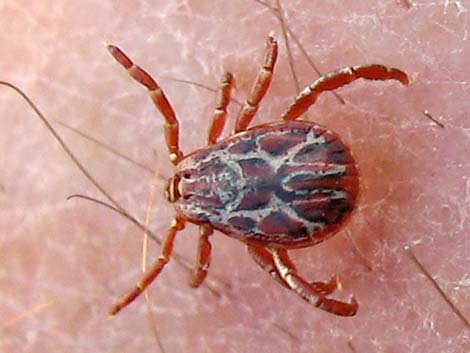Invertebrates Around Las Vegas, Wildlife Around Las Vegas
 Dermacentor hunteri, a Hard Tick usually found on Desert Bighorn Sheep, occasionally found on hikers. Female. |
Ticks are blood-sucking, obligate parasites. I might add that they are disgusting, but interesting when you get to know them. Ticks come in two basic varieties: Hard Ticks and Soft Ticks, with many species of each type. All ticks have complex life cycles, although the life cycle of hard ticks is more complex. Hard Ticks have mouth parts that point forward, and they have a hard exterior (or at least a hard dorsal shield). Hard ticks parasitize a variety of hosts, and depending on the growth stage of the tick, the larvae might feed on one species, the nymphs feed on another, and the adult on something else. When ready to feed, these ticks climb up onto a piece of vegetation that is the right height for the hapless victim. For example, a young tick that wants to feed on a Cactus Mouse might climb onto a short blade of grass, while an adult that wants to feed on a large mammal like a Desert Bighorn Sheep might climb onto a shrub or tall grass stem. |
 Dermacentor hunteri, a Hard Tick usually found on Desert Bighorn Sheep, occasionally found on hikers. Male. |
In contrast, Soft Ticks have mouth parts that point down, and they have a leathery exterior. Soft ticks usually parasitize birds and mammals that use nests, providing a regular site for the ticks to feed and develop. Some species of birds change nests with every clutch to avoid these ticks. Soft Ticks are also found on Desert Tortoise, living in tortoise burrows, sucking blood when the tortoises are home, and sometimes going for a ride to a new burrow. Because they live in the nests and burrows of other animals, Soft Ticks are unlikely to feed on humans, but if they do, they can pass diseases quickly. Two species of ticks that commonly feed on Desert Tortoises (Ornithodorus parkeri and Ornithodorus turicata) can transmit bacterial spirochetes (Borrelia parkeri and Borrelia turicatae, respectively) that cause American Tickborne Relapsing Fever in humans. |
 Ornithodorus turicata, a Soft Tick, on a Desert Tortoise (© 2007 S. Ferrand). |
Adult Hard Ticks often feed on humans. Hard Ticks carry a variety of diseases, but fortunately, most tick bites do not transmit diseases to humans in part because ticks usually need to be attached for a long time before diseases are transmitted. Most people have heard of Rocky Mountain Spotted Fever and Lyme Disease, fairly common tick-borne diseases. One particularly horrible tick-borne "disease" is Tick Paralysis. I've seen this in mice, and the thought of it happening to me is enough to keep me awake at night. Tick Paralysis occurs when a tick bites you in the back of the neck at the base of your skull. The tick saliva affects the nervous system and causes total paralysis while the tick is attached. Fortunately, after the tick feeds and drops off, the symptoms disappear, but the nightmares probably last a lifetime. The only place in southern Nevada where I know ticks to be a problem for humans is in the Arrow Canyon Range, where the Hard Tick Dermacentor hunteri seems to be fairly common. I've rarely seen ticks at Red Rocks, Lake Mead, or Mt. Charleston, places that all have plenty of opportunities for ticks, although there has been at least one case of Lyme Disease on Mt. Charleston. I've also heard of at least one tick in the Black Mountains (Sloan Canyon NCA). |
Note: All distances, elevations, and other facts are approximate.
![]() ; Last updated 230811
; Last updated 230811
| Inverts Around Las Vegas | Wildlife Around Las Vegas | Glossary | Copyright, Conditions, Disclaimer | Home |